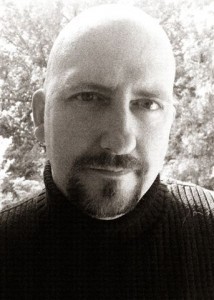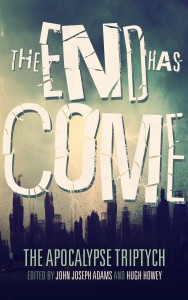
In collaboration with editors John Joseph Adams and Hugh Howey, A Dribble of Ink is proud to introduce a series of interviews with the authors of The End Has Come, the final volume in the The Apocalypse Triptych. Following on The End is Nigh, and The End Is Here, The End Has Come contains 23 stories about life after the apocalypse.
Interview with Jake Kerr about “The Gray Sunrise”
(Interview by Gwen Whiting)
The characters are under threat because of an encroaching astronomical event. What made you select this particular trigger for your apocalypse?
This is actually the fourth story set in this world. The original was “Biographical Fragments of the Life of Julian Prince,” which can be found in the Wastelands 2 anthology. John asked if I would be interested in setting my Apocalypse Triptych stories in that world, and so I wrote all three in them, all set in the same time frame and setting of an impending near extinction asteroid strike. Why did I originally choose an asteroid strike? I honestly can’t remember. My first thought was of a character and an epic event, and that was the first thing that popped into my mind!
A dominant theme that seems to prevail in some of your work, particularly “The Gray Sunrise” and “The Old Equations,” is the meaning of human relationships. This particular piece is largely about Don and his connection with his teenage son. Tell us a little bit about how you conceptualized that relationship. Is Don based on you or someone you know?
I love writing about relationships, how we interact with each other as human beings—the pain, the joy, the dawning comprehension of something deep and powerful changing within us. My first two Triptych stories are ultimately depressing. There is joy in “Wedding Day,” but it is tragic, ending in death. “Penance” is comfort and acceptance found through death, as well. Those stories looked at love and guilt through the lens of darkness and sadness. I wanted “The Gray Sunrise” to be a story of hope.
As to conceptualizing the story, first of all, all three stories in the Triptych are stand-alones, but they all have characters that overlap, although it is not obvious. Don is, in fact, the same man that is mentioned in “Wedding Day” as having already escaped on his boat. So I knew I wanted there to be a middle-aged to older man who escapes on a boat. I also wanted it to be a personal story, and the concept of having a father/son dynamic seemed to be powerful to me. Finally, I had to create a story with tension but also end with hope. The initial idea was actually of Don’s dream to own his own yacht, and how that dream led to their salvation. That led me to create the scenario of a father who starts the story full of hope, with a son who starts the story apathetic and nihilistic. The story starts with only one dream, that of Don hoping to survive to once again experience his lifelong dream of being on his boat and watching the sun rise over the water. Through the horrors they experience, I loved the idea of one dream dying while another one is born, until we have the end of the story there is only one dream, and it isn’t the dream that starts the story.
I tried to put a lot into this story, and certainly one of the pieces is the idea that, as a father, sometimes you give up your own dream for your child’s, and the process of doing that saves your life in the end, symbolically and literally.
Throughout the story, the main character Don returns to his daydreams of owning a yacht. Is there something significant that the yacht signifies to you personally or is it unique to this story?
I wish I could say that I chose a yacht for a grand symbolic reason, but the truth is that I was trying to link a character from “Wedding Day” or “Penance” to the new story, and the one that made the most sense was the relative from ‘Wedding Day” who fled on his yacht. So I started with the yacht as a plot point, not any grand dream or symbol. But ultimately it is symbolic in that it represents Don’s dream, and a big part of the story is seeing how his dream for the future and the physical representation of that dream are both battered by the storms resulting from the asteroid strike.
Was there a particular moment or scene in this piece that you found difficult to write? If so, why?
All of the scenes that required knowledge of yachting. I had the distinct fortune of having Hugh Howey as an editor. He is a yachtsman, and he thus caught every mistake, and there were a lot of them. I went with my normal approach of, “do enough research to fake it,” and then sent the story to an editor who couldn’t be faked. But ultimately they weren’t difficult to write, just difficult to get past Hugh!
Do you think that humanity will experience an apocalyptic event at some point in the future? If so, what form do you think the apocalypse is likely to take?
Yes, “the future” is a very long time. I don’t know how an apocalypse for the human race will manifest itself. There are so many possibilities, and that thought alone is frightening.
About Jake Kerr
Jake Kerr began writing short fiction in 2010 after fifteen years as a music and radio industry columnist and journalist. His first published story, “The Old Equations,” appeared in Lightspeed and went on to be named a finalist for the Nebula Award and the Theodore Sturgeon Memorial Award. He has subsequently been published in Fireside Magazine, Escape Pod, and the Unidentified Funny Objects anthology of humorous SF. A graduate of Kenyon College with degrees in English and Psychology, Kerr studied under writer-in-residence Ursula K. Le Guin and Peruvian playwright Alonso Alegria. He lives in Dallas, Texas, with his wife and three daughters.

Buy The End Has Come, edited by John Joseph Adams and Hugh Howey
About the anthology
Famine. Death. War. Pestilence. These are the harbingers of the biblical apocalypse, of the End of the World. In science fiction, the end is triggered by less figurative means: nuclear holocaust, biological warfare/pandemic, ecological disaster, or cosmological cataclysm.
But before any catastrophe, there are people who see it coming. During, there are heroes who fight against it. And after, there are the survivors who persevere and try to rebuild.
Edited by acclaimed anthologist John Joseph Adams and bestselling author Hugh Howey, The Apocalypse Triptych is a series of three anthologies of apocalyptic fiction. The End Is Nigh focuses on life before the apocalypse. The End is Now turns its attention to life during the apocalypse. And The End Has Come focuses on life after the apocalypse.
Buy the book
The End Has Come is available as a trade paperback or eBook.
